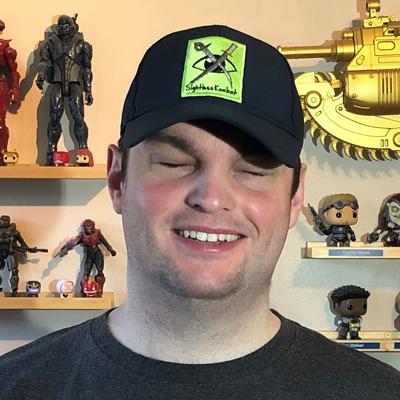The first online edition of #GAconf was held on 28th-29th September across Zoom and Discord.
ALL PREVIOUS CONFERENCES

A look at how the game accessibility field has evolved over the past year – how the landscape has shifted, where the industry is currently at, and where it needs to head in future.

HyperDot, an action arcade game, lends itself naturally to accessible design, but once the game made it into the hands of content creators with disabilities we learned about so many ways to make the game even more accessible.

We all know that building controller remapping into a game from the ground up is the best practice, but sometimes you don’t have that luxury. This talk will cover practical lessons from shipping controller remapping in Destiny 2, a live service game that had already existed in the wild for 3 years, and all of the challenges and considerations we faced when adapting the feature to an existing technology and framework.

A panel of four blind gamers, each with differing experiences and perspectives, come together to discuss just what gaming is all about. From opinions on audio-only titles and their personal preference for platform, to just where they’d like to see the industry in the next several years.

Every d/Deaf/Hard-of-Hearing (DHH) person has a unique experience and diagnosis. Deafness can range from mild to profound and while some people may use hearing devices, others do not. This session explores the power of customization, and provides guidance on creating accessible experiences across the whole DHH spectrum.

At Be Player One, we wanted to know what are the expectations, frustrations and barriers met by people with disabilities, regarding video games. So, we asked them. Come watch our talk and discover our most striking findings.

A post mortem of addressing the font size issues that The Outer Worlds shipped with, that ended up giving players one of the widest ranges of text sizes available today.

Members of the Numinous Design team will share the challenges and opportunities in designing accessibility first games. Drawing on experience from their currently in-design one-button game for kids, Ryan and Mike will share successes and failures in the ongoing design process. They will also share how their game fits into a broader “Playability Initiative” which is seeking to build a coalition of players, advocates and designers to connect disabled players with games they’ll love.

This talk will take you on the journey of a triple A game studio as they learned about the importance of inclusive design and how they grew the passion of a few into a studio wide expectation for the Gears of War franchise. Gears 5 released in 2019, and while we know we still have work to do it garnered some of the highest accessibility scores of this generation.

In this talk we´ll share some of our research into accessibility of FPS games, the challenges and approach for communicating the findings with a large and varied game development team, and how small actions toward accessibility can grow to have a large impact. In addition to insights into our methods for evaluating FPS accessibility, key takeaways should give listeners an idea of how to begin these conversations directly with developers in production, resulting in the team being more informed and knowledgeable about where to take action.

SEQUENCE STORM — a PC rhythm game — was transformed from an inaccessible game into one with many accessibility features. Those include full accessibility for blind players. Developer Daniel Lemon talks about the process of turning an inaccessible game into an accessible one.

In this session, two members of the Xbox Research Accessibility Team, Melissa Boone and Anna Waismeyer, will speak about their experiences growing an accessibility research program at Xbox, the benefits and challenges of conducting user research for games accessibility, and practical tips for how other teams can do it on their own.

This panel brings together accessibility full-timers from around the game industry to share their experiences starting as inclusion advocates to creating official programs and teams with organization-wide impact.

Excitement for a game starts to build months, often years, before that game is released. We see teasers, trailers, gameplay, previews, demos, dev interviews, reviews, etc. All to help market the game so as many people as possible will want to buy your game. Unfortunately, there is almost no info about accessibility being published. This needs to change. In this talk Accessibility Advocate Steve Saylor will offer suggestions on how and when accessibility info should be included in marketing your game.

A look at a few games made by independent developers and their accessibility efforts that often go unnoticed or under-represented. These games prove that including accessible design is often more of a case of knowledge, creativity, and care rather than budget; efforts that deserve recognition and understanding on how to bring access to a wide variety of experiences.

Owlchemy Labs has devoted significant resources into the research and development of a state of the art framework for XR subtitles. The framework creates comfortable and legible subtitles that perfectly integrate into the spatial medium of XR. Owlchemy deployed this framework in their highly-praised Vacation Simulator and Job Simulator subtitle updates. Owlchemy COOwl and Cable Slinger, Andrew Eiche, will walk through the subtitle framework in-depth, leaving attendees with a sense of how they could implement effective subtitles in their own XR games.

In this session, you’ll learn about the history of game accessibility and how one old school gamer learned to adapt in an era before adaptive technology existed.

In this talk, Tara urges you to take care of yourself so you can do more. To help get you started, she offers some helpful tips.

With over 60 accessibility settings, The Last of Us Part II is the most ambitious game Naughty Dog has ever made and has been called “the most accessible game ever.” In this talk, lead designer Emilia Schatz and lead systems designer Matthew Gallant will chronicle the development process, including an in-depth focus on the features designed specifically for blind and low-vision players—a first for the studio. They’ll review how these features were planned for, tested, iterated upon, and shipped, as well as key learnings.